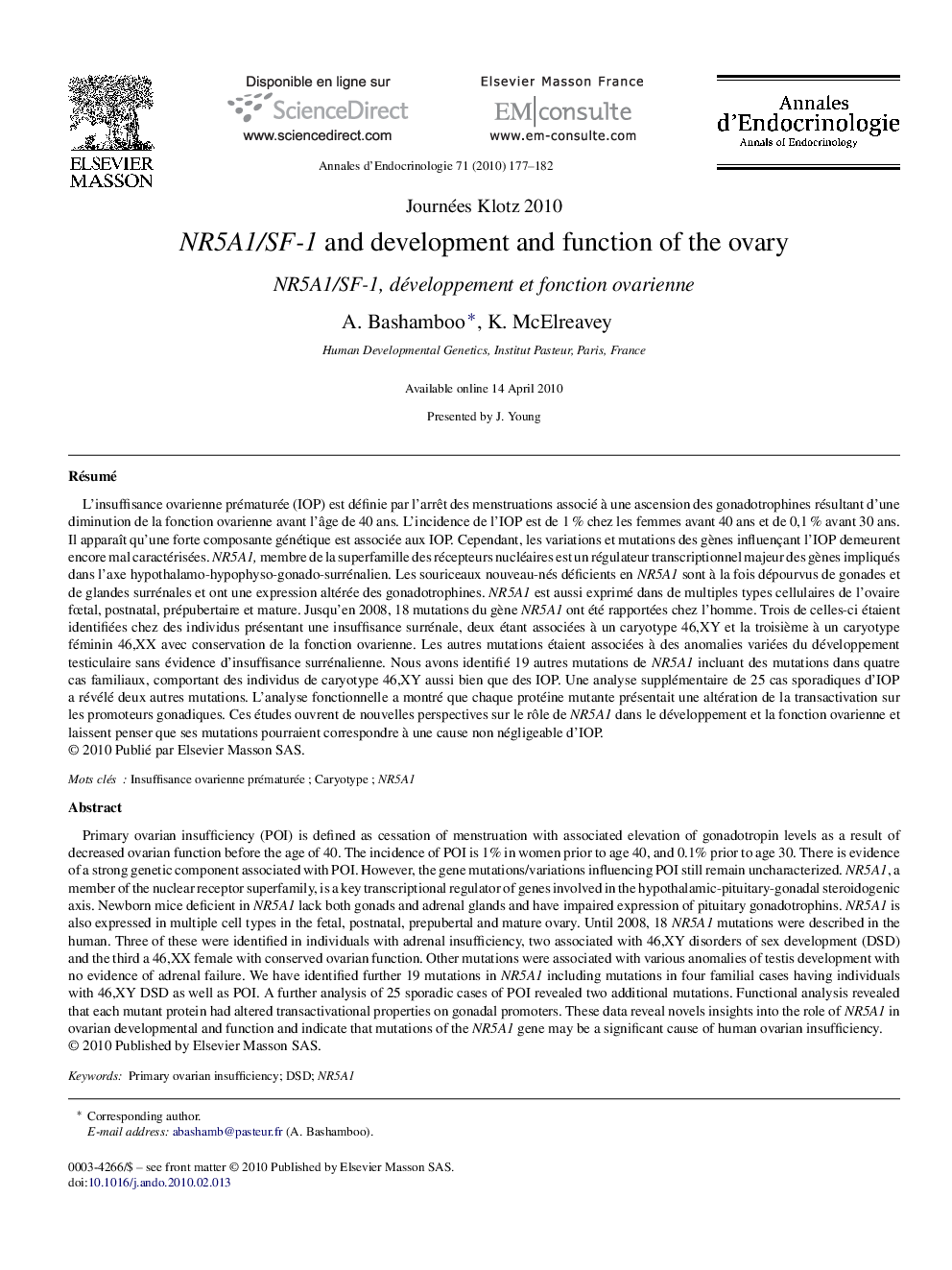| کد مقاله | کد نشریه | سال انتشار | مقاله انگلیسی | نسخه تمام متن |
|---|---|---|---|---|
| 3252575 | 1207067 | 2010 | 6 صفحه PDF | دانلود رایگان |

RésuméL’insuffisance ovarienne prématurée (IOP) est définie par l’arrêt des menstruations associé à une ascension des gonadotrophines résultant d’une diminution de la fonction ovarienne avant l’âge de 40 ans. L’incidence de l’IOP est de 1 % chez les femmes avant 40 ans et de 0,1 % avant 30 ans. Il apparaît qu’une forte composante génétique est associée aux IOP. Cependant, les variations et mutations des gènes influençant l’IOP demeurent encore mal caractérisées. NR5A1, membre de la superfamille des récepteurs nucléaires est un régulateur transcriptionnel majeur des gènes impliqués dans l’axe hypothalamo-hypophyso-gonado-surrénalien. Les souriceaux nouveau-nés déficients en NR5A1 sont à la fois dépourvus de gonades et de glandes surrénales et ont une expression altérée des gonadotrophines. NR5A1 est aussi exprimé dans de multiples types cellulaires de l’ovaire fœtal, postnatal, prépubertaire et mature. Jusqu’en 2008, 18 mutations du gène NR5A1 ont été rapportées chez l’homme. Trois de celles-ci étaient identifiées chez des individus présentant une insuffisance surrénale, deux étant associées à un caryotype 46,XY et la troisième à un caryotype féminin 46,XX avec conservation de la fonction ovarienne. Les autres mutations étaient associées à des anomalies variées du développement testiculaire sans évidence d’insuffisance surrénalienne. Nous avons identifié 19 autres mutations de NR5A1 incluant des mutations dans quatre cas familiaux, comportant des individus de caryotype 46,XY aussi bien que des IOP. Une analyse supplémentaire de 25 cas sporadiques d’IOP a révélé deux autres mutations. L’analyse fonctionnelle a montré que chaque protéine mutante présentait une altération de la transactivation sur les promoteurs gonadiques. Ces études ouvrent de nouvelles perspectives sur le rôle de NR5A1 dans le développement et la fonction ovarienne et laissent penser que ses mutations pourraient correspondre à une cause non négligeable d’IOP.
Primary ovarian insufficiency (POI) is defined as cessation of menstruation with associated elevation of gonadotropin levels as a result of decreased ovarian function before the age of 40. The incidence of POI is 1% in women prior to age 40, and 0.1% prior to age 30. There is evidence of a strong genetic component associated with POI. However, the gene mutations/variations influencing POI still remain uncharacterized. NR5A1, a member of the nuclear receptor superfamily, is a key transcriptional regulator of genes involved in the hypothalamic-pituitary-gonadal steroidogenic axis. Newborn mice deficient in NR5A1 lack both gonads and adrenal glands and have impaired expression of pituitary gonadotrophins. NR5A1 is also expressed in multiple cell types in the fetal, postnatal, prepubertal and mature ovary. Until 2008, 18 NR5A1 mutations were described in the human. Three of these were identified in individuals with adrenal insufficiency, two associated with 46,XY disorders of sex development (DSD) and the third a 46,XX female with conserved ovarian function. Other mutations were associated with various anomalies of testis development with no evidence of adrenal failure. We have identified further 19 mutations in NR5A1 including mutations in four familial cases having individuals with 46,XY DSD as well as POI. A further analysis of 25 sporadic cases of POI revealed two additional mutations. Functional analysis revealed that each mutant protein had altered transactivational properties on gonadal promoters. These data reveal novels insights into the role of NR5A1 in ovarian developmental and function and indicate that mutations of the NR5A1 gene may be a significant cause of human ovarian insufficiency.
Journal: Annales d'Endocrinologie - Volume 71, Issue 3, May 2010, Pages 177–182